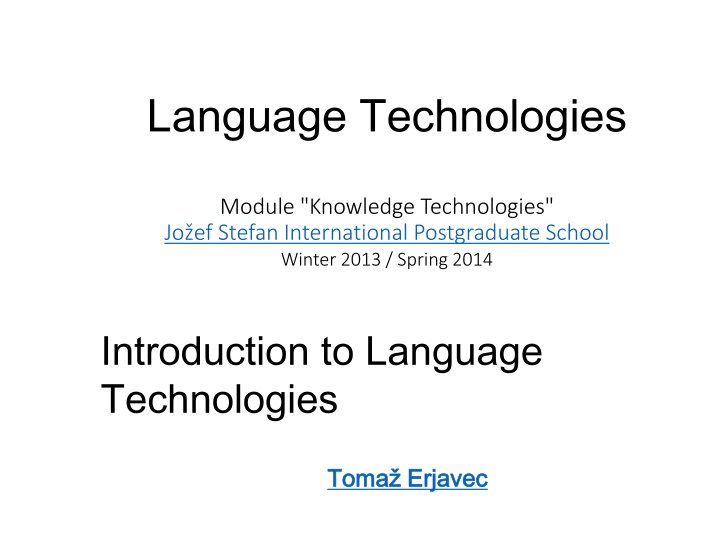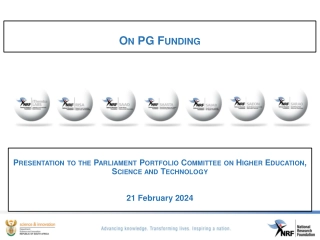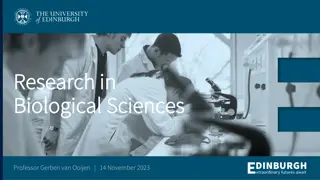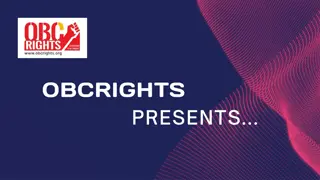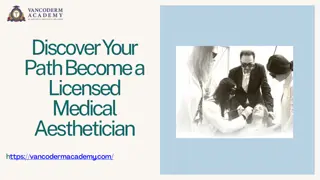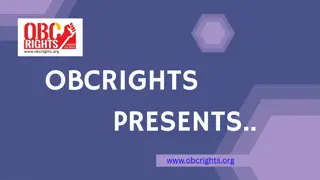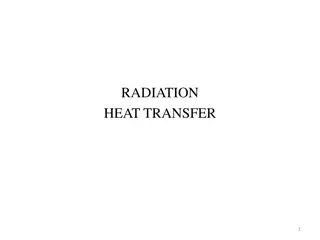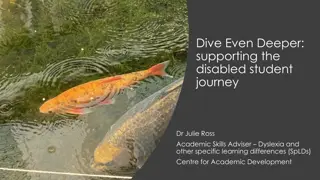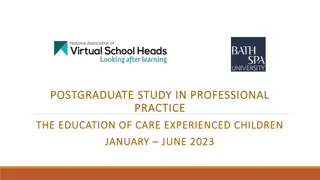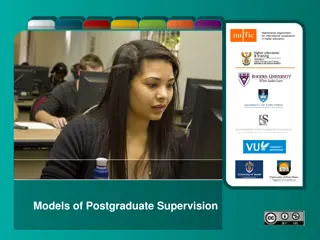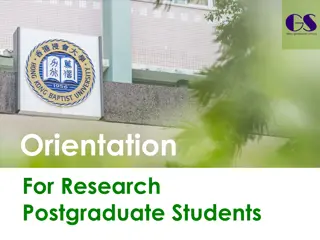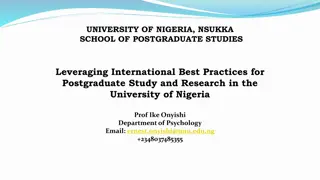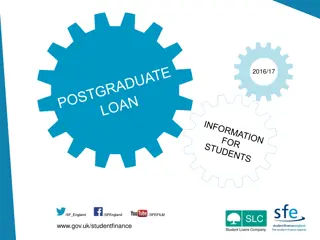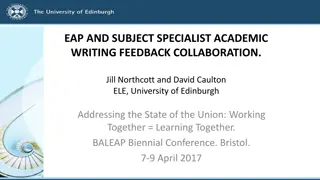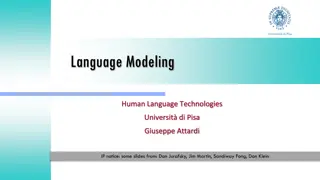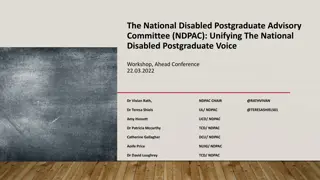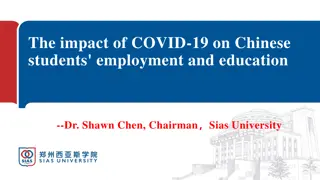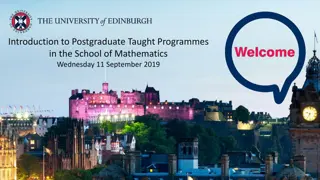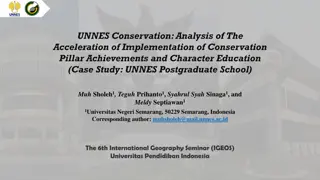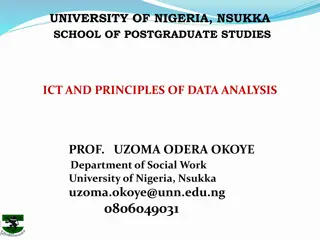Introduction to Language Technologies at Jožef Stefan International Postgraduate School
This module on Knowledge Technologies at Jožef Stefan International Postgraduate School explores various aspects of Language Technologies, including Computational Linguistics, Natural Language Processing, and Human Language Technologies. The course covers computer processing of natural language, applications, linguistic analysis levels, and language corpora. It delves into how computers understand language, addressing challenges such as ambiguity, vagueness, and paraphrases in linguistic processing.
Download Presentation

Please find below an Image/Link to download the presentation.
The content on the website is provided AS IS for your information and personal use only. It may not be sold, licensed, or shared on other websites without obtaining consent from the author.If you encounter any issues during the download, it is possible that the publisher has removed the file from their server.
You are allowed to download the files provided on this website for personal or commercial use, subject to the condition that they are used lawfully. All files are the property of their respective owners.
The content on the website is provided AS IS for your information and personal use only. It may not be sold, licensed, or shared on other websites without obtaining consent from the author.
E N D
Presentation Transcript
Language Technologies Module "Knowledge Technologies" Jo ef Stefan International Postgraduate School Winter 2013 / Spring 2014 Introduction to Language Technologies Toma Erjavec Toma Erjavec
Basic info Lecturer: http://nl.ijs.si/et/ tomaz.erjavec@ijs.si Work: language resources for Slovene, linguistic annotation, standards, digital libraries Course homepage: http://nl.ijs.si/et/teach/mps13-hlt/
Assessment Seminar work on topic connected with HLT quality of work quality of report Today: intro lecture, presentation of some possible topics + choosing the topic by students May / June: submission of seminar Make appointments for consultations by email.
Overview of the lecture 1. Computer processing of natural language 2. Applications 3. Some levels of linguistic analysis 4. Language corpora
I. Computer processing of natural language Computational Linguistics: a branch of computer science, that attempts to model the cognitive faculty of humans that enables us to produce/understand language Natural Language Processing: a subfield of CL, dealing with specific computational methods to process language Human Language Technologies: (the development of) useful programs to process language
Languages and computers How do computers understand language? AI-complete: To solve NLP, you d need to solve all of the problems in AI Turing test Engaging effectively in linguistic behavior is a sufficient condition for having achieved intelligence. But little kids can do NLP
Problems Languages have properties that humans find easy to process, but are very problematic for computers: Ambiguity: many words, syntactic constructions, etc. have more than one interpretation Vagueness: many linguistic features are left implicit in the text Paraphrases: many concepts can be expressed in different ways Humans use context and background knowledge; both are difficult for computers
Ambiguity I scream / ice cream It's very hard to recognize speech. It's very hard to wreck a nice beach. Squad helps dog bite victim. Helicopter powered by human flies. Jack invited Mary to the Halloween ball.
Structuralist and empiricist views on language The structuralist approach: Language is a limited and orderly system based on rules. Automatic processing of language is possible with rules Rules are written in accordance with language intuition The empirical approach: Language is the sum total of all its manifestations Generalisations are possible only on the basis of large collections of language data, which serve as a sample of the language (corpora) Machine Learning: data-driven automatic inference of rules
Other names for the two approaches Rationalism vs. empiricism Competence vs. performance Deductive vs. Inductive: Deductive method: from the general to specific; rules are derived from axioms and principles; verification of rules by observations Inductive method: from the specific to the general; rules are derived from specific observations; falsification of rules by observations
Problems with the structuralist approach Disadvantage of rule-based systems: Coverage (lexicon) Robustness (ill-formed input) Speed (polynomial complexity) Preferences (ambiguity: Time flies like an arrow ) Applicability? (more useful to know what is the name of a company than to know the deep syntactic structure of a sentence)
Empirical approach Describing naturally occurring language data Objective (reproducible) statements about language Quantitative analysis: common patterns in language use Creation of robust tools by applying statistical and machine learning approaches to large amounts of language data Basis for empirical approach: corpora Empiricism supported by rise in processing speed and storage, and the revolution in the availability of machine-readable texts (WWW)
III. HLT applications Speech technologies Machine translation Question answering Information retrieval and extraction Text summarisation Text mining Dialogue systems Multimodal and multimedia systems Computer assisted: authoring; language learning; translating; lexicology; language research
Machine translation Perfect MT would require the problem of NL understanding to be solved first! Types of MT: Fully automatic MT (Google translate, babel fish) Human-aided MT (pre and post-processing) Machine aided HT (translation memories) Problem of evaluation: automatic (BLEU, METEOR) manual (expensive!)
Rule based MT Analysis and generation rules + lexicons Problems: very expensive to develop, difficult to debug, gaps in knowledge Option for closely related languages (Apertium)
Statistical MT Parallel corpora: text in original language + translation Texts are first aligned by sentences On the basis of parallel corpora only: induce statistical model of translation Noisy channel model, introduced by researchers working at IBM: very influential approach Now used in Google translate Open source: Moses Difficult getting enough parallel text
Information retrieval and extraction Information retrieval (IR) searching for documents, for information within documents and for metadata about documents. bag of words approach Information extraction (IE) a type of IR whose goal is to automatically extract structured information, i.e. categorized and contextually and semantically well-defined data from a certain domain, from unstructured machine-readable documents. Related area: Named Entity Recognition identify names, dates, numeric expression in text
Corpus linguistics Large collection of texts, uniformly encoded and chosen according to linguistic criteria = corpus Corpora can be (manually, automatically) annotated with linguistic information (e.g. PoS, lemma) Used as datasets for linguistic investigations (lexicography!) training or testing of programs
Levels of linguistic analysis Phonetics and phonology: speech synthesis and recognition Morphology: morphological analysis, part-of-speech tagging, lemmatisation, recognition of unknown words Syntax: determining the constituent parts of a sentence and their syntactic functio Semantics: word-sense disambiguation, automatic induction of semantic resources (thesauri, ontologies) Multilingual technologies: extracting translation equivalents from corpora, machine translation Internet: information extraction, text mining, advanced search engines
Morphology Studies the structure and form of words Basic unit of meaning: morpheme Morphemes pair meaning with form, and combine to make words: e.g. dog/DOG,Noun + -s/plural dogs Process complicated by exceptions and mutations Morphology as the interface between phonology and syntax (and the lexicon)
Types of morphological processes Inflection (syntax-driven): run, runs, running, ran gledati, gledam, gleda, glej, gledal,... Derivation (word-formation): to run, a run, runny, runner, re-run, gledati, zagledati, pogledati, pogled, ogledalo,... Compounding (word-formation): zvezdogled, Herzkreislaufwiederbelebung
Inflectional Morphology Mapping of form to (syntactic) function dogs dog + s / DOG [N,pl] In search of regularities: talk/walk; talks/walks; talked/walked; talking/walking Exceptions: take/took, wolf/wolves, sheep/sheep English (relatively) simple; inflection much richer in e.g. Slavic languages
Syntax How are words arranged to form sentences? *I milk like I saw the man on the hill with a telescope. The study of rules which reveal the structure of sentences (typically tree-based) A pre-processing step for semantic analysis Common terms: Subject, Predicate, Object, Verb phrase, Noun phrase, Prepositional phr., Head, Complement, Adjunct,
Example of a phrase structure and a dependency tree
Examples of recent work on Slovene sloWNet: semantic lexicon Resources of the project Communication in Slovene , http://eng.slovenscina.eu/ Sloleks: large inflectional lexicon ssj500k: hand annotated corpus: PoS tags, lemmas, dependencies, named entities ccGifafida, ccKRES: reference PoS tagged and lemmatised corpora GOS: speech corpus, olar: language mistakes and corrections, IMP resources of historical Slovene: goo300k: hand-annotated corpus: modernised words, PoS tags, lemmas Lexicon of historical forms Digital library / automatically annotated corpus Other corpora
